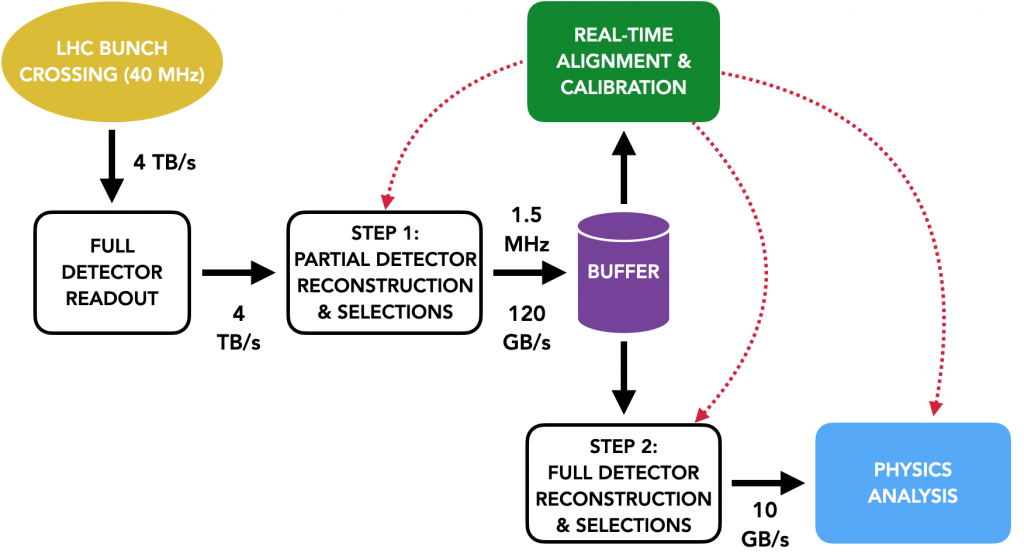When LHCb is up and running at full capacity, the detector registers around 25 million crossings of the Large Hadron Collider proton beams every second. Recording all of these ‘events’, each of which contains an average of six proton collisions, is virtually impossible due to limited storage capacity. So, in order to cherry-pick the best of them, LHCb employs an electronic system called a ‘trigger’ to filter the most interesting of these events in real time.
The heart of LHCb’s trigger is the data acquisition system which uses around 160 computer servers equipped with 480 custom electronic cards to receive and aggregate information from the full detector for each event in real time. This information, coming from around 1 million individual electronic channels and corresponding to around 4 Terabytes each second, is then made available for further processing, which is split into two distinct stages.

In the first stage, the data from all events is sent to Graphics Processing Units (GPU) located in the same servers which aggregate the detector data. This compact system minimizes overheads associated with moving such large quantities of data around. Each GPU processes around 150 thousand events a second, keeping the full detector information for around 3% of the most interesting events for further processing. This remaining data corresponds to 120 Gigabytes, or around 30 DVDs worth of information, per second.
At this stage, the remaining events are recorded to a 40 Petabyte disk buffer. This buffer allows the detector’s physical position to be established with micrometer precision in real time, in a process known as ‘alignment’. The performance of the detector for identifying different particle types is similarly calibrated with permille accuracy in real time. This real-time alignment and calibration ensures that LHCb retains optimal sensitivity for the many precision measurements which are a cornerstone of the collaboration’s physics programme. The presence of the disk buffer also allows the second trigger stage to be executed even when the LHC is not colliding protons, maximizing the utility of LHCb’s computing resources.
Once optimal detector performance is assured, the alignment and calibration constants are propagated to the second trigger stage, which is deployed on around 3700 computer servers. These machines perform the ultimate-quality reconstruction of the full detector and deploy around 1000 different selections to further reduce the data volume by around a factor 10. The exceptional quality of LHCb’s real-time reconstruction allows these selections to not only cherry-pick interesting events but also to compress the raw detector data into high-level physics objects in real-time. This process, known as real-time analysis allows LHCb a tremendous flexibility to select both the most interesting events and the most interesting pieces of each event, thus making best use of its computing resources for the full diversity of its physics programme. In the end around 10 Gigabytes of data are permanently recorded each second and made available to physics analysts.
More information about the trigger system used by the first LHCb detector from 2009 to 2018
More information about the current LHCb detector trigger system
